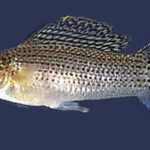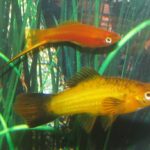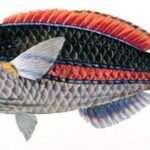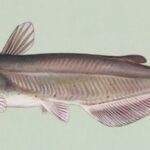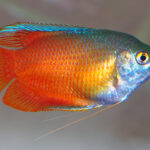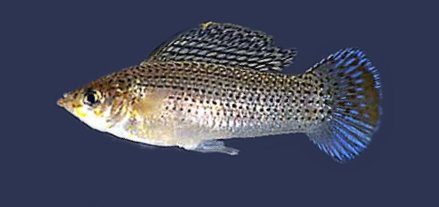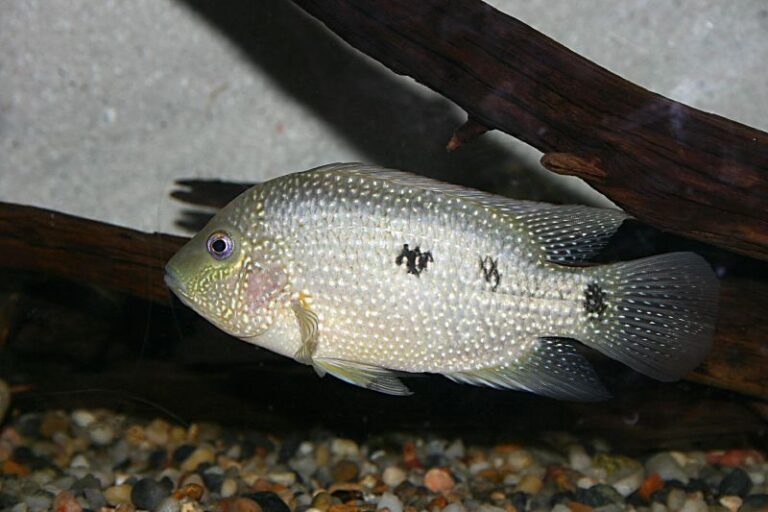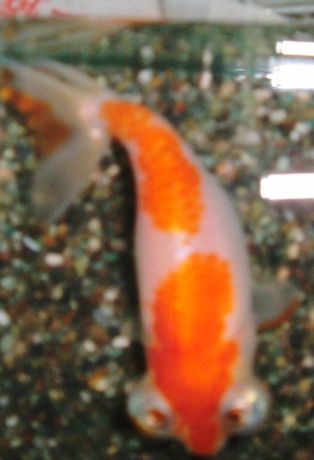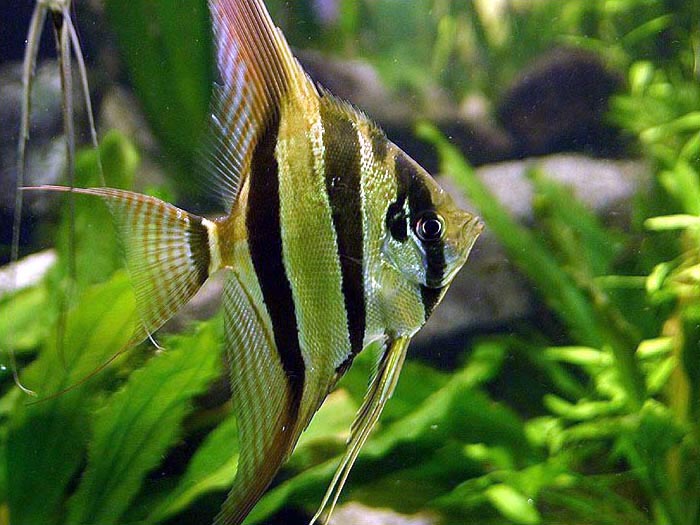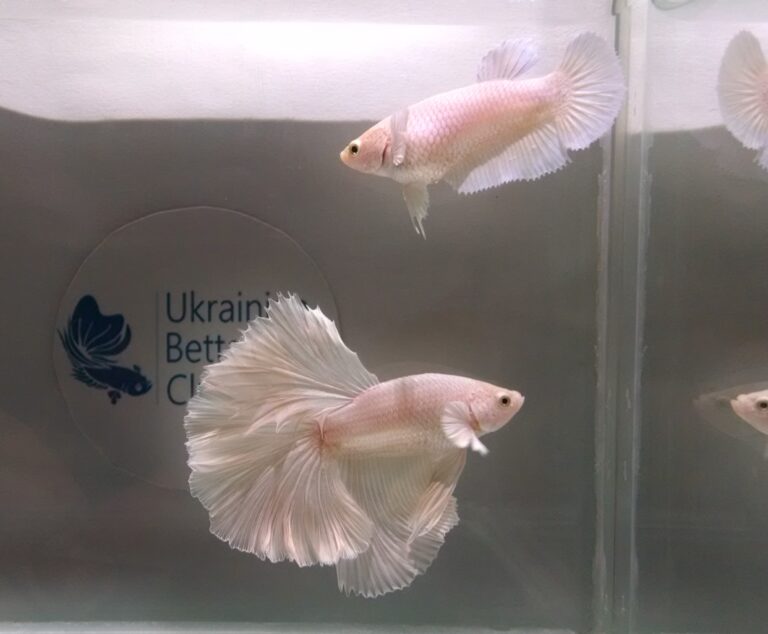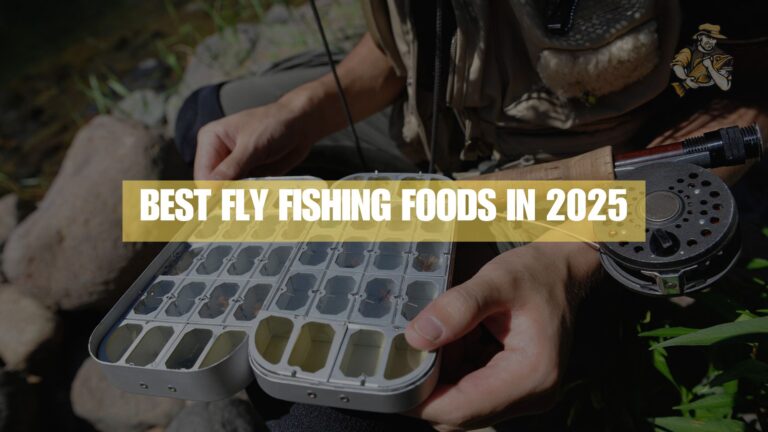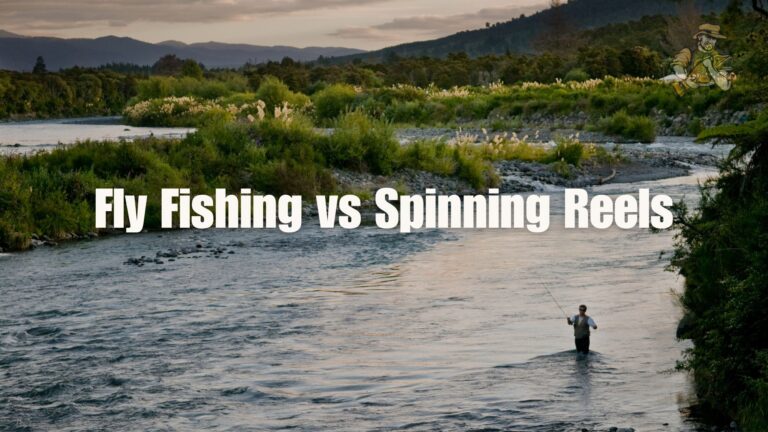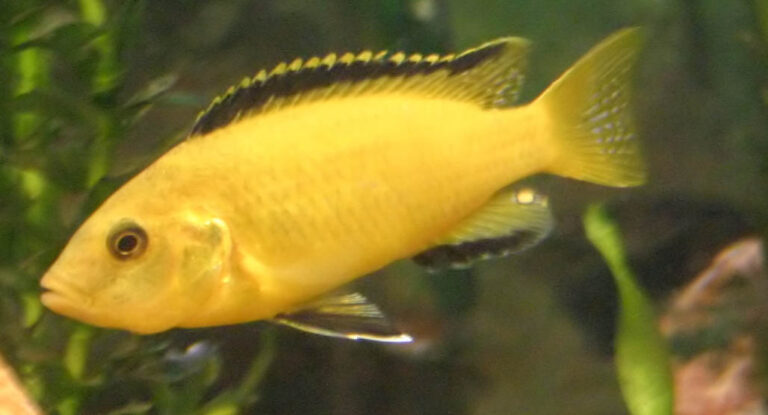Lemon Tetra
By Ryan Maron | Last Modified: June 8, 2025
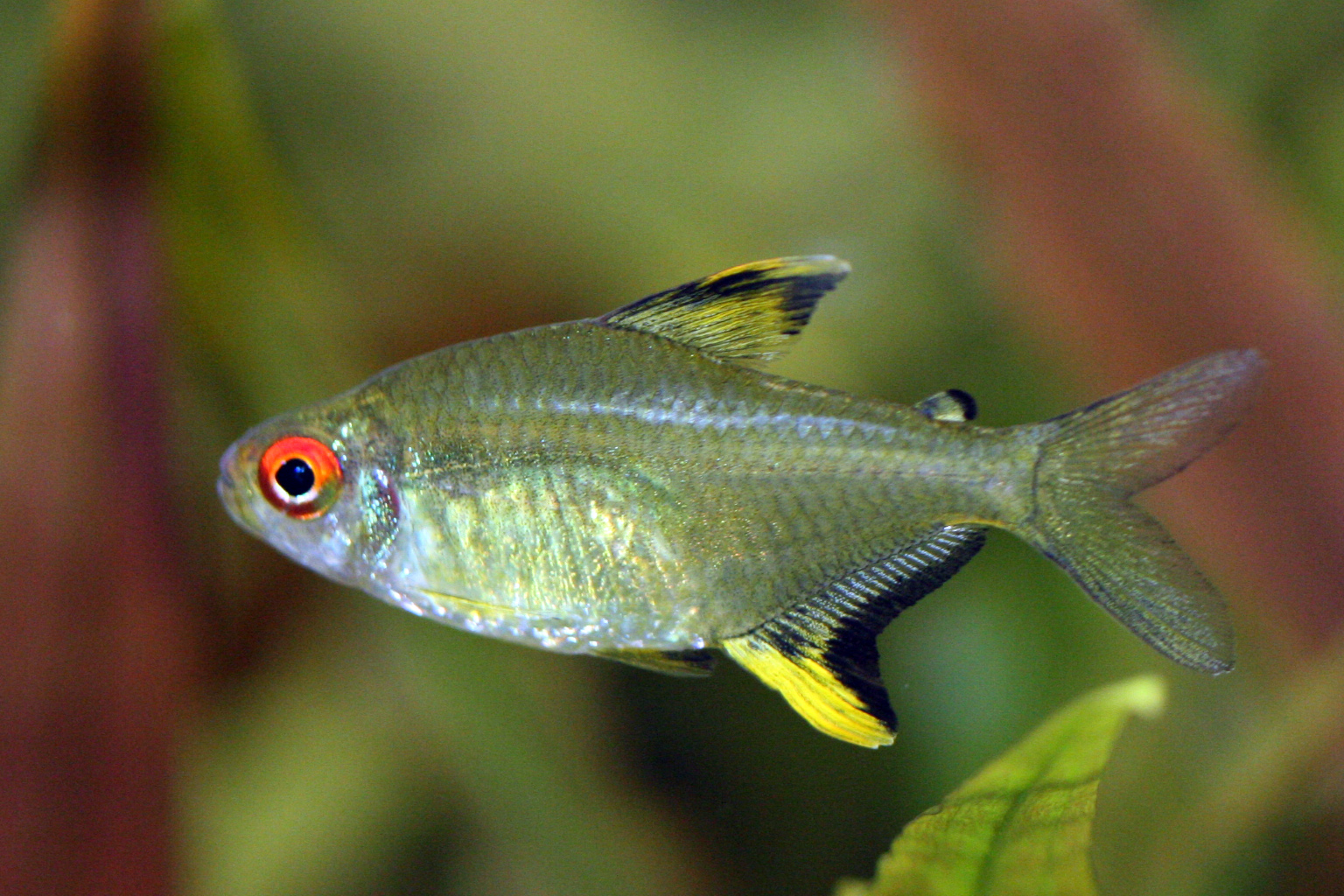
The Lemon Tetra (*Hyphessobrycon pulchripinnis*) stands as one of South America’s most vibrant freshwater fish species, distinguished by its brilliant yellow coloration and peaceful schooling behavior. This small characin fish plays a crucial ecological role in the Amazon Basin’s complex aquatic food webs, serving as both a primary consumer of small invertebrates and an essential food source for larger predatory fish species. Native to the slow-moving tributaries and flooded forests of Brazil and Peru, the Lemon Tetra has become increasingly important in both ecological research and the global aquarium trade, making it a species of significant scientific and economic interest.
The species exemplifies the remarkable biodiversity found within South American river systems, where countless small fish species form the foundation of aquatic ecosystem stability. As a mid-level consumer, the Lemon Tetra helps regulate populations of small crustaceans, insect larvae, and other microorganisms while providing sustenance for birds, reptiles, and larger fish species throughout its range.
| Feature | Details |
|---|---|
| Common Name | Lemon Tetra |
| Scientific Name | Hyphessobrycon pulchripinnis |
| Family | Characidae |
| Typical Size | 4-5 cm (1.5-2 inches), 2-4 grams |
| Habitat | Slow-moving tributaries and flooded forests |
| Diet | Omnivorous – small invertebrates and plant matter |
| Distribution | Amazon Basin, Brazil and Peru |
| Conservation Status | Least Concern |
Taxonomy & Classification
The Lemon Tetra belongs to the family Characidae, one of the largest and most diverse freshwater fish families in the world. First described by scientist Carl H. Eigenmann in 1907, *Hyphessobrycon pulchripinnis* represents a classic example of Neotropical characin evolution. The genus *Hyphessobrycon* encompasses over 140 recognized species, making it one of the most speciose genera within the tetra family.
The species’ taxonomic classification reflects its evolutionary relationships within the broader characiform lineage. Kingdom Animalia, Phylum Chordata, Class Actinopterygii, Order Characiformes, Family Characidae, Genus *Hyphessobrycon*, Species *pulchripinnis*. The specific epithet “pulchripinnis” derives from Latin, meaning “beautiful fins,” referencing the species’ distinctive fin coloration and patterns.
Molecular phylogenetic studies have revealed that the Lemon Tetra shares close evolutionary relationships with other yellow-bodied *Hyphessobrycon* species, suggesting a common ancestor that developed bright coloration as an adaptive strategy. Recent genetic analysis indicates that the species diverged from its closest relatives approximately 8-12 million years ago during the Miocene epoch, when major geological changes reshaped South American river systems.
The taxonomic position of *H. pulchripinnis* within the Characidae family places it among the most evolutionarily successful freshwater fish groups. This family’s remarkable adaptive radiation has produced over 1,100 described species, with new species continuing to be discovered throughout South America’s vast river networks.
Physical Description
The Lemon Tetra exhibits a distinctive torpedo-shaped body profile typical of schooling characins, measuring between 4-5 centimeters in total length when fully mature. The species’ most striking feature is its brilliant yellow coloration, which ranges from pale lemon-yellow to deep golden-yellow depending on environmental conditions, stress levels, and breeding status. The body’s base color intensifies significantly during spawning periods, creating a vivid display that serves both courtship and territorial functions.
The dorsal fin displays a characteristic black margin bordered by bright yellow, creating a distinctive pattern that helps distinguish the Lemon Tetra from similar species. The anal fin extends prominently from the body’s ventral surface, featuring a translucent yellow coloration with subtle black edging. The caudal fin exhibits a forked profile with yellow rays and dark margins, providing efficient propulsion during rapid swimming movements.
Body scales are cycloid and relatively large for the species’ size, creating a smooth, streamlined surface that reduces drag during swimming. The lateral line system, clearly visible along the body’s midline, contains approximately 32-35 scales and serves as a crucial sensory organ for detecting water movement and nearby objects. The species’ relatively large eyes, positioned laterally on the head, provide excellent peripheral vision essential for predator detection and schooling coordination.
Sexual dimorphism becomes apparent in mature specimens, with males displaying more intense coloration and slightly longer fin extensions. Females typically exhibit a more rounded body profile, particularly when carrying eggs, and their yellow coloration tends to be more subdued. The species’ mouth is relatively small and terminal, reflecting its feeding strategy focused on small prey items and plant matter.
Habitat & Distribution
The Lemon Tetra inhabits the vast Amazon Basin river system, with confirmed populations in Brazil’s Tapajós, Xingu, and Tocantins river basins, as well as Peru’s Ucayali and Marañón tributaries. These fish demonstrate a strong preference for slow-moving waters with moderate current flow, typically found in secondary channels, backwaters, and seasonally flooded forest areas known as várzeas.
Water parameters in their natural habitat remain relatively stable throughout the year, with temperatures ranging from 24-28°C (75-82°F) and pH levels between 6.0-7.5. The dissolved oxygen content typically measures 5-8 mg/L, supported by the constant flow of well-oxygenated water from upstream sources. Conductivity levels remain low, usually below 100 μS/cm, reflecting the soft water characteristics of Amazonian tributaries.
During the annual flood season, which occurs from December through May, Lemon Tetras migrate into flooded forest areas where they exploit abundant food resources among submerged vegetation and fallen trees. These seasonal movements can span distances of 50-100 kilometers, following predictable patterns that have evolved over thousands of years. The species shows remarkable adaptability to changing water levels, readily adjusting their habitat use as conditions fluctuate.
The substrate in their preferred habitats consists primarily of fine sand mixed with decomposing organic matter, creating a rich environment for invertebrate populations. Dense aquatic vegetation, including species of *Echinodorus*, *Cabomba*, and various floating plants, provides essential cover and foraging opportunities. Water transparency varies seasonally, from relatively clear during dry periods to turbid during flood seasons when sediment loads increase dramatically.
Microhabitat selection within their range appears linked to food availability and predator abundance. Similar habitat preferences are observed in many tetra fish species throughout the Amazon Basin, suggesting convergent evolution in response to similar ecological pressures.
Diet & Feeding Behavior
The Lemon Tetra exhibits omnivorous feeding behavior, demonstrating remarkable flexibility in diet composition that varies seasonally and geographically. Primary food sources include small crustaceans such as copepods and cladocerans, aquatic insect larvae, particularly chironomids and mayfly nymphs, and various microorganisms found in the water column and substrate surface.
During the dry season, when water levels recede and prey concentrations increase, Lemon Tetras focus heavily on planktonic organisms and small invertebrates. Their feeding strategy involves continuous grazing throughout daylight hours, with peak activity occurring during early morning and late afternoon periods. The species employs both surface feeding and mid-water column foraging, adapting their feeding position based on prey availability and environmental conditions.
Plant matter constitutes approximately 20-30% of their natural diet, including algae, small seeds, and decomposing plant material. This vegetarian component becomes particularly important during flood seasons when traditional prey items become dispersed across vast areas. The species’ digestive system has evolved to efficiently process both animal and plant materials, featuring a relatively long intestinal tract that facilitates nutrient extraction from diverse food sources.
Feeding behavior within schools demonstrates coordinated movement patterns, with individuals maintaining consistent spacing while foraging. This schooling behavior during feeding provides multiple advantages, including increased foraging efficiency through information sharing and reduced individual predation risk. When one individual locates a concentrated food source, others quickly respond to visual and chemical cues, leading to group feeding events.
The species’ feeding apparatus, including pharyngeal teeth and gill rakers, is optimized for capturing and processing small prey items. Pharyngeal teeth exhibit a crushing pattern suitable for breaking down small crustacean exoskeletons, while the gill rakers function as efficient filters for retaining planktonic organisms during feeding.
Behavior & Adaptations
Lemon Tetras exhibit highly developed schooling behavior, forming aggregations that can range from small groups of 10-20 individuals to massive schools containing several hundred fish. This collective behavior serves multiple adaptive functions, including predator dilution, enhanced foraging efficiency, and improved hydrodynamic performance during swimming. School formation follows specific patterns, with larger individuals typically occupying central positions while smaller fish maintain peripheral locations.
The species demonstrates remarkable sensory adaptations that facilitate school coordination and environmental awareness. Their lateral line system detects minute water movements, enabling rapid response to approaching predators or sudden environmental changes. Visual coordination within schools relies on the recognition of specific body postures and color patterns, with stressed individuals displaying darker coloration that signals potential danger to nearby conspecifics.
Diurnal activity patterns show distinct phases, with peak activity occurring during dawn and dusk periods when light levels provide optimal conditions for feeding while maintaining predator awareness. During midday hours, schools often seek shelter among aquatic vegetation or near structural features such as fallen logs or rock formations. Nighttime behavior involves formation of tight aggregations in protected areas, with reduced movement and feeding activity.
Territorial behavior emerges during breeding periods, when males establish small territories within the school’s general area. These temporary territories, typically measuring 30-50 centimeters in diameter, serve as courting sites where males display enhanced coloration and perform specific swimming patterns to attract females. Territory defense involves aggressive displays rather than physical contact, with dominant males maintaining prime locations through persistent courtship displays.
The species exhibits remarkable adaptability to changing environmental conditions, demonstrating behavioral plasticity that has contributed to their widespread distribution throughout the Amazon Basin. During periods of environmental stress, such as oxygen depletion or temperature fluctuations, schools modify their swimming patterns and habitat use to optimize survival chances.
Reproduction & Life Cycle
Lemon Tetra reproduction follows seasonal patterns closely linked to Amazonian flood cycles, with peak spawning activity occurring during the early flood season from November through February. This timing coincides with rising water levels and increased food availability, providing optimal conditions for egg development and fry survival. Sexual maturity is typically reached at 8-10 months of age when individuals attain approximately 75% of their adult size.
Courtship behavior involves complex ritualized displays where males establish temporary territories and perform elaborate swimming patterns to attract females. Males develop intensified coloration during breeding periods, with their yellow pigmentation becoming particularly vibrant. Successful courtship leads to pair formation, though individual males may spawn with multiple females during a single breeding season.
Spawning typically occurs during early morning hours in areas with dense aquatic vegetation or fine-leaved plants that provide suitable substrate for egg attachment. Females release 200-400 adhesive eggs in small batches, with males immediately fertilizing each batch through simultaneous sperm release. The entire spawning process may extend over several hours, with pairs repeatedly returning to preferred sites for additional egg deposition.
Egg development proceeds rapidly in the warm Amazonian waters, with hatching occurring within 24-36 hours post-fertilization. Newly hatched larvae measure approximately 3-4 millimeters in length and possess a prominent yolk sac that provides nutrition during the first 3-4 days of development. Free-swimming fry begin active feeding on microscopic organisms, particularly infusoria and newly hatched brine shrimp nauplii.
Juvenile growth rates depend heavily on food availability and environmental conditions, with optimal conditions supporting growth rates of 0.5-1.0 millimeters per week during the first month. Mortality rates are highest during the first two weeks of life, with survival heavily dependent on the availability of appropriate-sized food organisms and the absence of predation pressure. Juvenile Lemon Tetras form small aggregations that gradually merge with adult schools as they mature, typically achieving full adult size within 6-8 months under favorable conditions.
Predators & Threats
The Lemon Tetra faces predation pressure from a diverse array of Amazonian predators throughout its life cycle. Primary predators include larger characins such as piranhas (*Serrasalmus* and *Pygocentrus* species), cichlids including peacock bass (*Cichla* species), and various catfish species that inhabit similar environments. Aerial predators pose significant threats, particularly kingfishers, herons, and other piscivorous birds that target schools feeding near the surface.
Juvenile Lemon Tetras experience the highest predation rates, with virtually all fish species in their habitat posing potential threats to individuals smaller than 2 centimeters. Aquatic insects, particularly giant water bugs and dragonfly larvae, represent major predators of newly hatched fry and small juveniles. This intense predation pressure has shaped the species’ schooling behavior and habitat selection patterns.
Habitat degradation represents an increasingly serious threat to Lemon Tetra populations throughout their range. Deforestation along riverbanks eliminates critical spawning habitat and reduces the input of terrestrial organic matter that supports the aquatic food web. Agricultural runoff introduces pesticides and fertilizers that can disrupt reproductive cycles and reduce survival rates of sensitive developmental stages.
Climate change impacts are becoming increasingly apparent in Amazonian ecosystems, with altered precipitation patterns affecting flood timing and duration. These changes can disrupt the species’ reproductive cycle, which has evolved to coincide with specific environmental conditions. Prolonged droughts reduce available habitat and concentrate populations in smaller areas, increasing competition and predation pressure.
The aquarium trade, while providing economic benefits to local communities, can create collection pressure on wild populations if not properly managed. Sustainable collection practices are essential to prevent overexploitation of accessible populations near human settlements. Water pollution from mining activities, particularly gold mining operations, introduces heavy metals and sediments that can severely impact water quality in critical habitats.
Human development along major rivers has led to increased boat traffic, which can disrupt schooling behavior and create noise pollution that interferes with the species’ sensory systems. Dam construction poses long-term threats by altering natural flow patterns and blocking migration routes essential for the species’ life cycle.
Conservation Status
The International Union for Conservation of Nature (IUCN) currently classifies the Lemon Tetra as “Least Concern” based on its wide distribution throughout the Amazon Basin and stable population trends in most areas. However, this classification may not fully reflect localized population declines in areas experiencing intense human development or environmental degradation.
Population monitoring efforts remain limited throughout much of the species’ range, making accurate assessment of population trends challenging. Available data suggests that populations remain stable in protected areas and regions with minimal human impact, while areas experiencing deforestation, mining, or intensive agriculture show evidence of population decline.
The species benefits from several large-scale conservation initiatives focused on Amazon Basin protection. The Amazon Cooperation Treaty Organization coordinates multinational efforts to preserve critical habitats, while various national parks and reserves provide protected habitat throughout the species’ range. Brazil’s National System of Conservation Units includes numerous protected areas that encompass important Lemon Tetra habitats.
Research priorities for Lemon Tetra conservation include long-term population monitoring, assessment of climate change impacts, and evaluation of sustainable collection practices for the aquarium trade. Collaborative research programs between Brazilian and Peruvian institutions are beginning to address these knowledge gaps through coordinated field studies.
Conservation strategies must address both habitat protection and sustainable use practices. Community-based conservation programs that provide economic alternatives to destructive practices show promise for protecting critical habitats while supporting local livelihoods. Education programs targeting aquarium collectors and exporters can promote sustainable harvesting practices that maintain wild populations.
The species’ conservation status may warrant reassessment as more comprehensive population data becomes available. Climate change projections suggest that Amazonian fish communities will face increasing pressure from altered precipitation patterns and temperature increases, potentially affecting species currently considered stable.
Human Interaction
The Lemon Tetra has developed significant economic importance within the global aquarium trade, ranking among the most commonly exported South American ornamental fish species. Annual export numbers from Brazil and Peru exceed 100,000 individuals, generating substantial revenue for local communities involved in collection, holding, and transportation activities. This trade provides important economic opportunities in remote Amazonian communities where alternative income sources are limited.
Aquarium keeping of Lemon Tetras has contributed to increased public awareness of Amazonian biodiversity and conservation issues. The species’ peaceful nature and striking appearance make it an ideal ambassadorial species for promoting interest in South American aquatic ecosystems. Educational programs in public aquariums frequently feature Lemon Tetras as representatives of Amazonian fish diversity.
Collection practices for the aquarium trade have evolved significantly over the past two decades, with increasing emphasis on sustainable harvesting methods. Training programs for local collectors focus on selective harvesting techniques that minimize impact on wild populations, including size-selective collection and seasonal restrictions during breeding periods. These initiatives help ensure long-term population viability while maintaining economic benefits for local communities.
Scientific research involving Lemon Tetras has contributed valuable insights into Amazonian fish ecology, behavior, and evolution. The species serves as a model organism for studying schooling behavior, predator-prey relationships, and adaptation to seasonal environmental changes. Research findings have broader applications for understanding fish community dynamics throughout tropical river systems.
Cultural significance of the Lemon Tetra varies among indigenous communities throughout its range. Some groups incorporate the species into traditional ecological knowledge systems, recognizing its role as an indicator of ecosystem health and seasonal changes. Traditional fishing practices generally have minimal impact on Lemon Tetra populations, as these communities typically target larger species for subsistence purposes.
The species’ popularity in the aquarium hobby has led to development of captive breeding programs that reduce pressure on wild populations. Successful breeding techniques developed by hobbyists and commercial breeders provide insights into reproductive biology and may contribute to conservation breeding programs if wild populations face future threats.
Interesting Facts
The Lemon Tetra possesses remarkable color-changing abilities that extend beyond simple stress responses. Individual fish can adjust their yellow pigmentation intensity within minutes, creating subtle communication signals within schools that help coordinate movement and feeding behavior. This chromatic communication system involves specialized cells called chromatophores that can rapidly redistribute pigment granules throughout the cell structure.
Despite their small size, Lemon Tetras demonstrate impressive swimming endurance, capable of maintaining cruising speeds of 3-4 body lengths per second for extended periods. During seasonal migrations, individuals have been tracked covering distances exceeding 100 kilometers, navigating complex river systems with remarkable precision. Their swimming efficiency results from specialized muscle fiber arrangements and streamlined body morphology.
The species exhibits unusual feeding behavior during ant fall events, when terrestrial ants accidentally fall into the water during their nuptial flights. Lemon Tetras can consume up to 50% of their body weight in ants during these seasonal feeding frenzies, storing excess energy as fat reserves that sustain them through periods of reduced food availability.
Lemon Tetras demonstrate remarkable memory capabilities, recognizing individual schoolmates and maintaining consistent social relationships within groups. Research has shown that individuals can remember specific feeding locations for up to three weeks and adjust their foraging patterns based on past experiences. This cognitive ability helps optimize foraging efficiency in complex Amazonian environments.
The species’ lateral line system contains approximately 35-40 neuromasts, sensory organs that can detect water movements as small as 0.01 millimeters. This exceptional sensitivity allows them to sense the approach of predators from distances exceeding 50 centimeters, providing crucial early warning that enables rapid escape responses.
Acoustic communication plays a previously underappreciated role in Lemon Tetra behavior. Recent research has identified low-frequency sounds produced during feeding and courtship activities, suggesting that these fish possess more complex communication systems than previously recognized. These vocalizations may help coordinate school movements in turbid water conditions where visual cues are limited.
The species exhibits unique spawning site fidelity, with individual pairs returning to the same spawning locations across multiple breeding seasons. This behavior suggests sophisticated spatial memory and navigation abilities that enable precise location finding in complex aquatic environments. Some pairs have been observed using the same spawning sites for up to three consecutive years.
Frequently Asked Questions
How long do Lemon Tetras live in the wild?
Wild Lemon Tetras typically live 3-4 years under natural conditions, though some individuals may reach 5 years in optimal environments. Lifespan is influenced by predation pressure, environmental conditions, and seasonal food availability. In captivity, with proper care and optimal conditions, they may live slightly longer due to reduced predation and consistent food supply.
Do Lemon Tetras require specific water conditions?
Lemon Tetras thrive in soft, slightly acidic water with pH levels between 6.0-7.5 and temperatures of 24-28°C. They prefer well-oxygenated water with low mineral content, reflecting their natural Amazonian habitat. Sudden changes in water parameters should be avoided, as the species is sensitive to rapid environmental fluctuations.
How many Lemon Tetras should be kept together?
Lemon Tetras are obligate schooling fish that require groups of at least 6-8 individuals to exhibit natural behavior patterns. Larger groups of 10-15 fish create more natural schooling dynamics and reduce stress levels. Solitary individuals or very small groups often display abnormal behavior and increased stress responses.
What distinguishes Lemon Tetras from other yellow tetra species?
Lemon Tetras can be distinguished by their specific fin patterns, particularly the black-edged dorsal fin with yellow coloration, and their overall body proportions. They typically display more consistent yellow coloration compared to similar species and have distinctive eye positioning and mouth shape. Proper identification often requires examination of multiple physical characteristics rather than relying on color alone.
Conclusion
The Lemon Tetra represents a remarkable example of Amazonian fish diversity, embodying the complex ecological relationships that characterize South American freshwater ecosystems. Its role as both predator and prey species makes it a crucial component of aquatic food webs throughout the Amazon Basin. As human pressures on Amazonian habitats continue to intensify, the continued monitoring and protection of species like the Lemon Tetra becomes increasingly important for maintaining ecosystem integrity and supporting the sustainable use of aquatic resources for future generations.
Share The Article:
More Fish Species:
-
Molly Fish
The Molly Fish represents one of the most adaptable and ecologically significant freshwater species in tropical and subtropical regions…
-
Texas Cichlid
The Texas Cichlid (Herichthys cyanoguttatus) stands as one of North America’s most distinctive freshwater fish species, representing the sole…
-
Dalmatian Molly
The Dalmatian Molly stands as one of the most recognizable and beloved freshwater aquarium fish, distinguished by its striking…
-
Celestial Eye Goldfish
The Celestial Eye Goldfish represents one of the most distinctive varieties within ornamental aquaculture, known scientifically as Carassius auratus….
-
Angelfish
Angelfish represent one of the most recognizable and ecologically significant families of marine fish, encompassing over 85 species distributed…
-
Rosetail Betta
The Rosetail Betta (Betta splendens) stands as one of the most visually striking variations within the diverse world of…
Discover
-
How to Find Good Fishing Spots That Actually Produce Fish
Finding productive fishing spots is often what separates successful anglers from those who go home empty-handed. It’s not just…
-
7 Best Fly Fishing Foods That Trout Can’t Resist in 2025
If there’s one thing I’ve learned after three decades of fly fishing, it’s that trout can be maddeningly selective…
-
Bora Bora Fishing: What I Learned After 3 Failed Trips
I still remember staring at those impossibly blue waters on my first morning in Bora Bora, thinking I was…
-
Spinner Shark
The Spinner Shark (Carcharhinus brevipinna) stands as one of the ocean’s most distinctive and acrobatic predators, earning its name…
-
River Fishing Techniques: Master the Moving Water
Fishing rivers presents a unique set of challenges and rewards that I’ve come to appreciate over my three decades…
-
California Fishing License Guide: Costs, Types & How to Buy (2025)
Getting your California fishing license might seem like a hassle, but it’s actually pretty straightforward once you know the…
Discover
-
Best Fishing Lures for Walleye: Pro Secrets You Won’t Believe
Let me tell you something about walleye fishing that most anglers get completely wrong. After 30+ years of chasing…
-
Largemouth Bass
The Largemouth Bass, scientifically known as *Micropterus salmoides*, stands as one of North America’s most iconic freshwater gamefish and…
-
Fly Fishing vs Spinning Reels: Choosing the Right Technique
If there’s one debate that never seems to end in fishing circles, it’s fly fishing versus spinning gear. I’ve…
-
Silky Shark
The Silky Shark represents one of the most widespread and ecologically significant requiem sharks in tropical and subtropical waters…
-
Yellow Lab Cichlid
The Yellow Lab Cichlid (*Labidochromis caeruleus*) stands as one of Africa’s most recognizable freshwater fish species, distinguished by its…
-
Ice Fishing Techniques for Anglers in 2025
Last January, I was out on Higgins Lake during that brutal cold snap – you remember, when it dropped…

